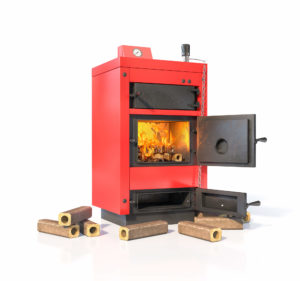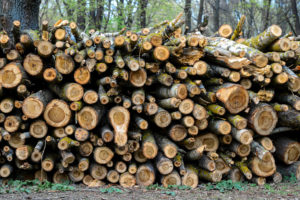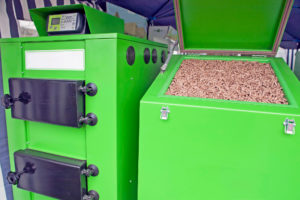Looking for ways to reduce your carbon footprint and adopt more sustainable solutions in your everyday life? You should out-commission your old gas boiler and replace it with a more modern biomass boiler that uses renewable plant-based materials instead of fossil fuel!
Biomass boilers burn wood pellets or chips to produce heat and boil water. Such materials are said to be carbon-neutral, as a growing tree takes up the carbon dioxide produced in the burning process to produce more wood, and the cycle continues.
Follow along as we explore the upsides and drawbacks of installing a biomass boiler and help you decide whether it fits your household well!
Contents
- 1 Key Takeaways
- 2 What Is a Biomass Boiler?
- 3 Biomass Fuel Sources
- 4 What Are the Upsides to Using Biomass Boilers?
- 5 What Are the Drawbacks to Using Biomass Boilers?
- 6 How to Choose the Best Biomass Boiler?
- 7 How Much Space Do I Need to Install a Biomass Boiler?
- 8 Frequently Asked Questions
- 9 Heat Pump Source: Reliable Heating and Cooling Solutions
- 10 Bottom Line
Key Takeaways
- Biomass boilers burn renewable plant-based materials, making them a carbon-neutral heating solution with lower carbon emissions than fossil fuel boilers.
- Biomass fuel sources include wood pellets, wood chips, and wood logs, each with advantages and disadvantages in terms of cost and convenience.
- The benefits of using biomass boilers include cost-effectiveness, reduced carbon emissions, government incentives, and convenient operation, but drawbacks include higher initial installation costs, space requirements, fuel refill involvement, specific flue requirements, and maintenance costs.
What Is a Biomass Boiler?
A biomass boiler operates similarly to conventional oil or gas boilers, with a significant distinction: it uses renewable, organic materials as fuel to provide heating and hot water for your home. This approach aligns with sustainable energy goals and offers an eco-friendly alternative to fossil fuel-based heating systems.
Recent developments in UK energy policy, including the transition from the Renewable Heat Incentive (RHI) to the Boiler Upgrade Scheme (BUS), reflect a concerted effort to encourage the adoption of greener heating technologies. While the RHI provided incentives for renewable heating solutions, the BUS, introduced to further support the shift towards low-carbon heating options, offers grants to help cover the installation costs of biomass boilers, among other renewable heating systems.
It’s important to note that discussions about phasing out gas boilers by 2025 are part of broader environmental objectives. However, specific policies and timelines can evolve, emphasising the importance of staying informed about the latest government announcements and schemes.
One practical aspect of using a biomass boiler is the need for manual refueling, which some may consider less convenient than the automated nature of gas or oil boilers. To mitigate this, biomass boilers can be equipped with a hopper that automatically feeds the boiler with fuel from a large storage container, simplifying the process and reducing the need for frequent manual intervention.

Biomass Fuel Sources
Biomass boilers built for domestic use depend on different wood byproducts as their fuel source. You might wonder how burning wood is a sustainable model. To put things in perspective, you have to account for the millions of years and extreme conditions needed to put out coal and other fossil fuel products.
Now you can appreciate how producing wood is more feasible with a lesser toll on the planet. Besides, biomass boilers can use wood waste products like pellets and chips that go into landfills anyways and end up among piles of waste.
Let’s explore some of the different biomass fuel sources and see how they stack against one another.
Wood Pellets
Many households in the UK go for wood pellets as the preferred fuel source for their biomass boilers, and for all the good reasons. Wood pellets are compact as they’re produced by pressing wood shavings and sawdust into a pellet form.
Don’t let their compact size fool you, as wood pellets are the most efficient biomass fuel of the bunch. Such pellets produce the most heat energy emissions upon combustion compared to other wood byproducts.
That’s not all; they’re also easier to store and handle compared to the chunkier wood logs. If you don’t want to be constantly involved with refilling your biomass boiler’s organic fuel compartment, you can pair the wood pellets with a hopper and get the peace of mind you deserve!
The hopper has a storage compartment that can hold up to a tonne of pellets, depending on the model you opt for. The machine then automatically feeds the boiler whenever you’re running low on biomass fuel.
For all their advantages, wood pellets don’t come cheap. Expect to spend anywhere around £490 per year to power up your biomass boilers with pellets. We’d say it’s worth it, considering how convenient the whole setup is.

Wood Chips
Next up are wood chips, which come at almost half the annual operation cost of their wood pellet counterparts. At £280 per year, you’re getting a more economical biomass fuel solution.
Before jumping into more technicalities, let’s take a step back to see how wood chips are produced. The process is way simpler than what we’ve touched upon with wood pellets. All it takes is running the wood logs into a chipping machine, and voila, you have your wood chips ready!
Even after being broken down, wood chips are still bulky and take up more space. This makes storage a bit of a hassle, especially if you’re planning to get all your winter requirements in one go. Also, transportation costs tend to be on the pricey end due to the wood chips’ sheer volume.
It’s worth noting that a hopper doesn’t work with wood chips. You’ll have to put in the work yourself and make sure your biomass boiler is refuelled manually.
Finally, wood chips can hold up more moisture compared to compact pellets. This makes the heating process less efficient, with less heat being produced for a given weight of chips as opposed to the same weight in pellets.

Wood Logs
By now, you might have noticed where this is going. We’re getting chunkier with each entry! Wood logs can be used as a means to fuel your biomass boiler. Nevertheless, you need to bear in mind that not all models can handle large logs. So, you need to ensure you’re getting a log boiler that’s able to burn up the chunkier wood pieces.
Log biomass boilers make sense for people living in rural communities with abundant wood waste products in the surrounding area. This way, you can virtually turn around your heating budget to zero.
Also, wood logs need generous storage areas if we’re talking about securing enough amount for the season. An extra shed or a large backyard can do the trick! The main takeaway here is that log boilers aren’t for everyone. However, if you fall beneath the target category, you’re getting an economical heating solution while keeping your carbon footprint to a minimum.

Others
Wood is the most widely adopted biomass fuel for domestic usage. However, it’s not the only organic fuel that can be used with boilers. If you head into the industrial space, you’ll come across boilers running on all sorts of biogenic materials, including paper, cotton, and other plant-based wastes.
Some boilers can also use crop wastes like corn, sugarcane, soybeans, and more. Animal manure can be used in some settings, proving that the sustainable energy space is an ever-evolving market looking for ways to recycle organic waste and reduce carbon emissions in the process.
What Are the Upsides to Using Biomass Boilers?
Let’s explore some benefits of adopting a biomass boiler.
Carbon Neutral
Boilers running on biomass fuel produce about one-tenth of the carbon emissions of their fossil fuel counterparts. Such a difference alone is worth investing in biomass boilers to reduce avoidable carbon emissions and doing right by our planet Earth!
It’s also worth noting that when plants die in nature, they release carbon as they decompose. And it’s true that burning wood for energy produces more carbon, but the amount that makes it to the atmosphere is more or less equal to that taken up by plants during photosynthesis. This explains how wood byproducts are considered carbon neutral.
Cost Effective Fuel
You might think that adopting eco-friendly solutions comes with a premium price tag; however, this is far from the truth. In fact, you’ll notice considerable savings on your utility bills upon abandoning gas boilers.
Biomass boilers depend on organic waste products and wood, which can be easily found for free if you’re based in a rural area. Even if you’re paying for your boiler’s wood pellets and chips, you’re still making savings in the long term, considering the constant fluctuations and price uncertainty surrounding fossil fuel.
More Efficient
The most efficient gas boilers will run you big bucks! We’re talking about those that can steadily convert 90% of the fuel they’re fed into energy.
Given the advances in heating technology, we can develop biomass fuel that achieves much of the same figures at a comparable price. So this eliminates the main adoption barrier and encourages more people to hop on the renewable energy train.
Qualify for Government Incentives
To support UK households in adopting eco-friendly heating solutions and reducing their carbon footprint, the government has introduced the Boiler Upgrade Scheme (BUS). This scheme offers substantial grants to homeowners in England and Wales who install biomass boilers or other renewable heating systems, such as air or ground source heat pumps.
The Boiler Upgrade Scheme provides a direct grant to help cover the initial installation costs, making green heating technologies more accessible and affordable. For example, homeowners can receive grants of up to £5,000 for installing a biomass boiler.
Convenient Operation
One of the selling points of gas boilers is their plug-and-play operation. The boiler gets its gas fuel from the intricate circuit of pipes and all you need to do is simply open a switch.
If you don’t want to give up such convenience of use, we have some good news for you. Many biomass boilers offer a degree of automation, allowing you to set time intervals at which the combustion chamber is being fed with wood pellets or chips.

What Are the Drawbacks to Using Biomass Boilers?
To ensure the switch to biomass boilers is as smooth and frustration-free as possible, you should review some of the drawbacks that come with the transition. Sure, you can find a way around many of the inconveniences, but adjusting your expectations is key to enjoying your biomass boiler experience.
Price of Initial Installation Cost
Although it’ll pay for itself in the long term, the initial installation cost of biomass boilers remains a hefty sum. You might need anything between £3,500 to £16,500 to get your biomass boiler up and running, making it a pricey investment for some.
In comparison, premium gas boilers might go for around £2,450, which is a more gullible pill to swallow. However, biomass boilers take the prize in terms of operation cost, making your investment worthwhile down the line.
Eats Up Space
For biomass boilers to operate, they need a sizable combustion chamber where the wood pellets are burnt to give out energy. This makes the size of the entire unit three times bigger than their gas-powered counterparts with the same kilo-wattage.
Add this to the storage space needed to keep your reserve of wood pellets, chips, or logs, and you’ve got yourself a setup that eats up a lot of space. Plan your home’s space utilisation wisely before signing up for a biomass boiler.
Fuel Refill Involvement
The biomass model you get dictates how much you’re willing to be involved with your heating system setup. For instance, log boilers require a constant supply of wood logs. So, you should put in the work to cut down wood logs into appropriate sizes and constantly ensure your boiler’s combustion chamber doesn’t run dry.
Even the fully-automated models with the feeding chamber require your occasional involvement once all the pellets are used up. So, it’s all about the frequency of your involvement, as no solution can give you a completely hands-free experience.
Specific Flue Requirements
To ensure your biomass boiler is running safely, you need to have a well-designed exhaust pipe network to take the exhaust outside your house. If you have an existing chimney in place, the biomass boiler’s flue can be seamlessly integrated.
If that’s not the case, you might be looking at extensive renovation work and planning to create a flue system from the ground up.
If the proposed alterations might affect the building’s roofline, you might need approval to proceed forward with your home renovations. This could be a time-consuming process in addition to the extra cost needed for all the required house reworks.
Maintenance Cost
Biomass boilers require constant maintenance to ensure they’re running smoothly. You’ll have to clean the ash and soot remains from the combustion chamber once a week if you opt for the manual models. On the other hand, automated boilers with a hopper can self-clean themselves, so you can check on them once a month instead.
Also, you need to ensure wood pellets and chips don’t clog up your boiler. And don’t sleep on oiling the hopper’s bearings, as such a simple step can save you tons of money in repair costs.
Aside from your personal efforts, it’s recommended to have your biomass boiler checked annually by a professional to deliver the needed service and ensure you’re always ahead of any issues before they materialise.

How to Choose the Best Biomass Boiler?
By now, you should have a solid idea about what qualities to look for in your biomass boiler. The available biomass fuel in your neighbourhood, the level of automation you’re comfortable with, and space limitations are among the factors that might govern your boiler choice.
That’s not all; we have some more qualities to bear in mind before finalising your purchase decision.
Manufacturer
You’re making a lifetime investment here, so it makes sense to look for a reputable boiler manufacturer that can provide exceptional post-purchase support for the years to come.
You’d be more comfortable dropping your hard-earned money on a boiler when knowing how long the manufacturer has been operating in the market space and how many units they sell annually in the UK.
Navien, Zanussi, and Ferroli are among the highly-regarder boiler brands in the UK, so it’s always a safe bet to opt for one of their biomass boiler offerings.
Burner Regulators
For a boiler to operate efficiently, you need a top-notch burner with dynamic controls. So look for a boiler that automatically controls airflow over the burner and constantly compares heat output to the demanded room temperature.
This way, you can enjoy your movie night from the warmth of your couch without having to fiddle around the burner controls every once in a while!
Temperature Controls
Following up on the burner control aspect of a boiler, you also need to consider its temperature control features. Some boilers give you a control board that covers your entire house, while others are limited to specific areas.
Also, certain types of boilers come with smart home integration and allow you to control individual room temperatures right from within a mobile app. So review the specs of your biomass boiler of choice and decide whether you need the added smart features or you’ll be fine with a more traditional one.
Warranty
One final aspect to bear in mind when choosing one biomass boiler over another is the post-purchase support services. Biomass boilers from household names give you at least two years of warranty to ensure your investment is well protected into the future.
That’s not all; you can also find boilers with extended warranties of up to five years. Read the fine print to ensure such a warranty covers both parts and labour. This way, you get the peace of mind you deserve for going green!

How Much Space Do I Need to Install a Biomass Boiler?
The size of the biomass boiler correlates to its power output, so you’d want to invest in a big unit to cover up your entire house. To put things into perspective, the average biomass boiler is as big as a four-drawer cabinet, so you might need to move some furniture around to make room for it.
We’ve already touched on how biomass boilers overshadow their gas counterparts in terms of physical size. This is because of the integrated hopper mechanism in addition to the sizable combustion chamber where the biomass fuel is loaded.
When adjusting your available space to fit a biomass boiler, you have to account for the biomass fuel storage area as well. A typical bulk delivery order of wood pellets might take up eight cubic meters, which should fit in a typical utility room.
On the other hand, if you went the log boiler route, you might need a much larger storage area. An empty shed should do the trick, provided it’s close enough to where your biomass boiler is placed. You don’t want to struggle with long journeys every time you need to refuel your boiler!
Frequently Asked Questions
What Is the Ideal Wood Chip Moisture?
Depending on the weather, time of the year, and storage conditions, wood chips can build up moisture. This will make them less efficient when burning and produce less overall heat. You want to keep your wood chip moisture levels around 35% to be in the clear.
Is a Biomass Boiler Suitable for my House?
Large properties that take forever to heat will benefit the most from the installation of a biomass boiler. If you’re living in a smaller flat with only one or two bedrooms, you might consider other eco-friendly alternatives to heat up your space.
Is a Biomass Boiler a Good Investment?
Yes, especially with the proposed ban on gas boilers that’ll kick into action by 2025. With fossil fuel out of the picture, your other good option is an electricity-powered boiler. This will take a great toll on your monthly utility bills. With that being said, a biomass boiler gets a home run for its cost-effective operation, carbon-neutral footprint, and efficiency.
Are Biomass Boilers Noisy?
No, the maximum noise level produced by biomass boilers doesn’t cross the 70 decibels mark. This is similar to the sound levels produced by a washing machine or a dishwasher. For the most part, people tend to place their biomass boilers in separate rooms, so noise won’t be an issue.
Heat Pump Source: Reliable Heating and Cooling Solutions
At Heat Pump Source, we take pride in our unwavering commitment to serving the UK with top-tier HVAC solutions. From the efficiency of heat pumps and the cool relief of air conditioning to the warmth of boilers, radiators, and underfloor heating, our dedicated team is always at the forefront of innovation. We understand the unique needs of every household and business, and we strive to provide dependable health and cooling products and services that are tailored just for you. Ensuring your comfort and satisfaction is our utmost priority. Whether you have questions, need guidance, or require support, we’re always here to assist. Please don’t hesitate to contact us; we’re eager to be of service.
Bottom Line
Biomass boilers give you a cost-effective, eco-friendly means to heat up your house. If you’re living in a large house with demanding heating requirements, these boilers make the most sense. All you need is enough room for installation and biofuel storage areas, and you’re all set up to cut down your carbon footprint while getting efficient heating performance!
About the Author
At Heat Pump Source, our articles are the product of a collaborative effort among a team of highly skilled HVAC experts. Our dedicated professionals, hailing from diverse backgrounds in heating, ventilation, air conditioning, and refrigeration, contribute their extensive knowledge and experience to every piece of content. This multidisciplinary approach ensures comprehensive coverage. Our commitment is to deliver authoritative, reliable, and tailored advice to meet the unique needs of every household and business across the UK.

